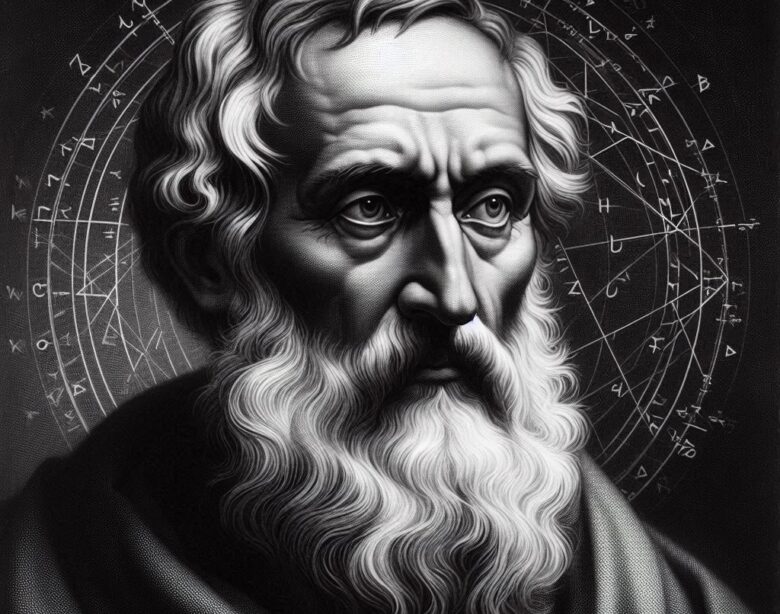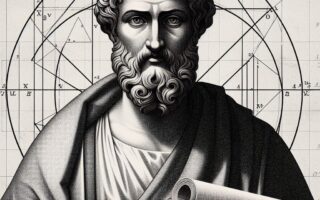The Father of Geometry
Euclid, often referred to as the “Father of Geometry,” was an ancient Greek mathematician whose work has had an enduring influence on mathematics and science for over two millennia. He is best known for his monumental treatise Elements, a 13-book compilation of mathematical knowledge that organized and systematized much of the mathematics known in his time. Euclid’s impact on geometry, logic, and the structure of mathematical proofs has been profound, shaping the development of mathematics from ancient civilizations through the Renaissance and into the modern era.
Early Life and Education
Euclid was born around 300 BCE, possibly in Alexandria, Egypt, during the reign of Ptolemy I, although very little is known about his personal life. Historians believe that Euclid may have been educated in Athens, where he could have studied at Plato’s Academy, which was known for its emphasis on mathematical and philosophical teachings. While we know very little about his upbringing and education, Euclid’s work indicates that he was deeply knowledgeable about the mathematical advancements of his predecessors, including the Pythagoreans, Plato, and Eudoxus of Cnidus.
After moving to Alexandria, Euclid established a school of mathematics, which became a center for mathematical learning in the Hellenistic world. Alexandria, with its famous library and intellectual atmosphere, provided the ideal environment for Euclid to conduct his research and compile his mathematical treatises.
Elements: A Masterpiece of Mathematical Organization
Euclid’s Elements is, without a doubt, his most important and lasting contribution to mathematics. The work consists of 13 books covering a wide range of topics in geometry, number theory, and mathematical logic. What makes Elements remarkable is not that Euclid introduced entirely new concepts but rather that he organized existing mathematical knowledge into a coherent and logical system.
The structure of Elements is what distinguishes it from earlier works. Euclid begins with a set of definitions, postulates (axioms), and common notions (general assumptions) and then builds a series of propositions, each logically derived from the preceding ones. This method of deriving complex results from a small set of fundamental principles is known as the axiomatic method, and it remains central to mathematical reasoning today.
Euclid’s first book begins with basic geometric concepts such as points, lines, and angles, and proceeds to establish foundational theorems, including the Pythagorean theorem. Subsequent books cover topics such as the properties of circles, the theory of proportions, the study of regular polygons, and the volume and surface area of solids.
The importance of Elements cannot be overstated. It was used as the primary textbook for teaching geometry in Europe for over a thousand years, and its influence extended beyond mathematics to other fields, including philosophy, logic, and science.
Euclid’s Contributions to Geometry
Euclid’s impact on geometry is unparalleled. His approach to geometry, now known as Euclidean geometry, is based on five fundamental postulates, which define the relationships between points, lines, and planes in a flat, two-dimensional space. These postulates include statements such as:
- A straight line can be drawn from any point to any other point.
- A finite straight line can be extended indefinitely in a straight line.
- A circle can be drawn with any center and any radius.
- All right angles are equal to one another.
- If a line intersects two other lines and forms interior angles on one side less than two right angles, then those two lines, if extended, will meet on that side.
From these simple postulates, Euclid was able to derive a vast array of geometric results. Many of the theorems Euclid proved are still taught in school geometry courses today, including the relationships between angles and triangles, the properties of parallel lines, and the areas of polygons and circles.
Euclid’s geometry remained the dominant framework for understanding space until the development of non-Euclidean geometries in the 19th century, which showed that alternative geometries could exist where the parallel postulate did not hold. Nevertheless, Euclidean geometry continues to be a foundational part of mathematical education and is essential for understanding the geometry of flat surfaces.
Euclid and Mathematical Rigor
One of Euclid’s most significant contributions to mathematics is his emphasis on rigor in mathematical proofs. Euclid’s Elements introduced a systematic method for proving mathematical theorems that relied on logical deduction from a small set of axioms. This approach set a new standard for mathematical precision and clarity.
Before Euclid, many mathematical results were known, but they were often presented without formal proof. Euclid’s insistence on proving every result from first principles helped establish the notion that mathematical truths should be based on logical deduction rather than intuition or empirical observation.
The rigor of Euclid’s methods influenced not only mathematicians but also philosophers and scientists. For example, the logical structure of Elements served as a model for the development of formal logic in the works of Aristotle and later philosophers. The clarity and precision of Euclid’s proofs also inspired mathematicians such as Isaac Newton and Carl Friedrich Gauss, who sought to apply similar rigor to their own work.
Euclid’s Contributions to Number Theory
While Euclid is most famous for his work in geometry, Elements also contains significant contributions to number theory, particularly in the study of prime numbers and divisibility.
In Book VII of Elements, Euclid presents the Euclidean algorithm, a method for finding the greatest common divisor of two numbers. This algorithm is still used today in modern computational mathematics for problems involving integer arithmetic.
Euclid also proved the infinitude of prime numbers, one of the most famous results in number theory. He showed that no finite set of prime numbers could account for all primes, which means that there are infinitely many prime numbers. This theorem laid the groundwork for centuries of research in number theory, leading to the development of modern fields such as cryptography, where prime numbers play a crucial role.
Euclid’s Influence on Science and Philosophy
Euclid’s influence extended beyond mathematics into other areas of intellectual inquiry. His systematic approach to knowledge and his use of logical reasoning made him a model for philosophers, scientists, and mathematicians alike.
In the realm of science, Euclid’s methods influenced the development of physics, particularly through the work of Isaac Newton. Newton’s laws of motion and universal gravitation are presented in Philosophiæ Naturalis Principia Mathematica with the same rigor and deductive structure that Euclid used in Elements. The clarity and logical rigor of Euclid’s work served as a foundation for Newton’s mathematical description of the physical world.
Euclid’s influence also reached philosophy, where his work served as a model for the development of formal logic. Philosophers such as Aristotle, who lived around the same time as Euclid, were inspired by the logical structure of mathematical proofs and sought to apply similar methods to philosophical arguments. Later philosophers, including René Descartes and Baruch Spinoza, also drew on Euclid’s work as a model for constructing logical, systematic arguments.
Euclid’s Legacy in Modern Mathematics and Science
Euclid’s contributions to mathematics have left a lasting legacy that continues to influence modern mathematics and science. Euclidean geometry remains a fundamental part of mathematics, taught in schools around the world, and his work on number theory is still relevant in fields such as cryptography and computer science.
Furthermore, the axiomatic method pioneered by Euclid has become a standard approach in mathematics. Modern mathematicians use this method to develop new theories, proving results based on a small set of axioms and ensuring that every step of a proof is logically sound.
Euclid’s insistence on rigor and logical deduction has also influenced other fields of science and engineering. The methods of mathematical proof developed by Euclid have become central to the scientific method, where hypotheses are tested through rigorous experimentation and logical reasoning.
Conclusion
Euclid’s impact on the history of mathematics and science is profound. His work in geometry, number theory, and mathematical logic laid the foundation for centuries of mathematical inquiry and provided a model of logical rigor that has influenced fields ranging from physics to philosophy.
While Euclidean geometry has been supplemented by non-Euclidean geometries in the modern study of space and mathematics, the clarity and structure of Euclid’s work remain an essential part of mathematical education and research. Euclid’s Elements continues to be one of the most influential books in the history of mathematics, and his legacy as the “Father of Geometry” remains unchallenged. Through his contributions to mathematical rigor and his systematic organization of knowledge, Euclid has left a lasting mark on the intellectual history of humanity.
Please Visit Our Sponsors:
We only support vendors that we use ourselves in our home. The links below are our own links or affiliate links but know that we use all of these now, or have in the past. As the author/creator of this blog, I also tutor mathematics on Wyzant, sell on Etsy, create content on TpT, and learn Korean on Rosetta Stone.





